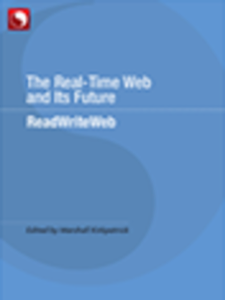“Recommended.”
-HP Official News

“Very thorough. Exceeded my expectations. Nice work.”
-Henry “Hank” Nothhaft, Jr.
Entrepreneur-in-Residence at SRI
“The report is excellent — a great synthesis of why the real time web is different, what changes, what doesn’t and what the industry needs in order to press forward.”
– John Borthwick
CEO, Betaworks
Those are just a few of the things that people have said about our newly released research report The Real-Time Web and its Future so far. Want to know what’s included in the report? Check out the Table of Contents and the full text of the Introduction below.
That’s the Table of Contents and below is the full text of the introduction to the report. We hope you’ll purchase this report via this link – and check out our package deals for purchasing the ReadWriteWeb Guide to Online Community Management as well!
What is The Real-Time Web? Beyond Twitter and Facebook
Dave Winer defines the real-time Web in four words: “It Happens Without Waiting.”1 That’s true, and appropriately vague. The phrase “real-time Web” means different things for different people and it’s too early in the game to have anything but a loose, inclusive definition.
Many of the different forms the real-time Web takes do have some common benefits, user experience elements, lessons learned, pitfalls and possibilities. This is what we explore in this report.
It’s definitely a whole lot more than just Twitter and Facebook, though these are the best known instances of what’s referred to as the real-time Web. Someday Facebook may open up its user data and play a larger role in the real-time Web than just the introduction to the stream model that it plays today. Someday Twitter may grow, discover how to retain users and effectively encourage more than the small number of people who today create the vast majority of content on that service. Today engineers estimate that Twitter sees about 1 thousand messages published per second and between 5 and 10 million links shared per day, before de-duplication. That sounds like a lot, but the real-time Web as a whole is already much, much larger than Twitter.
For infrastructure provider Kaazing, the real-time Web is using HTML5 Web Sockets technology to push live financial information to the Web browsers of banking customers that had always been limited to desktop applications for security reasons.
For consumer web app Pip.io, the real-time Web is creating an XMPP-powered chat-like experience for users to communicate with friends around objects like a Google Map or a streaming Netflix video playing in the Pip.io web OS.
For semantic recommendation company Evri, the real-time Web is the ebbing and flowing of traffic data on Wikipedia. That data points to hot topics that Evri needs to build topic pages to serve their publisher customers.
For search engine OneRiot, the real-time Web is made up of the links people share on Twitter …as well as Digg, Delicious and the click-streams of more than a million users who have opted-in to exposing what they see online through the OneRiot toolbar.
For Q&A service Aardvark, the real-time Web is the people inside the social circle of a user who happens to be available online at a given moment and interested in the topic of a user’s question.
There are hundreds of thousands of blogs that now deliver updated content to any other application that subscribes to a PubSubHubbub or RSSCloud feed, immediately after that content is published. NYU Journalism Professor Jay Rosen says the real-time Web creates a sense of flow for users that’s comparable to the way television holds our attention.
Google’s Brett Slatkin, developer of the PubSubHubbub real-time protocol, says the real-time Web is a foundation for efficient computing and use cases we can’t yet even imagine.
In writing this report we interviewed 50 people who work on technologies that power or leverage what they consider to be the real-time Web. Those people have had a very diverse array of experiences, but articulate a common story. It’s a story of increased computational efficiency – and software that struggles to keep users from feeling overwhelmed. It’s a story of radically new possibilities but strategies based on adding value in conjunction with more traditional, slower moving online resources.
We hope you enjoy reading this overview of the emerging real-time Web. We believe this phenomenon is one that will play a major role in the Web and world of the future.
The page-based model of destination sites, created by centralized expertise and navigated through authority-based search and clicking link by link is being transcended. We think this survey of current strategies and experiences to date will prove very useful in helping you effectively participate in and help build the future of the real-time Web.










